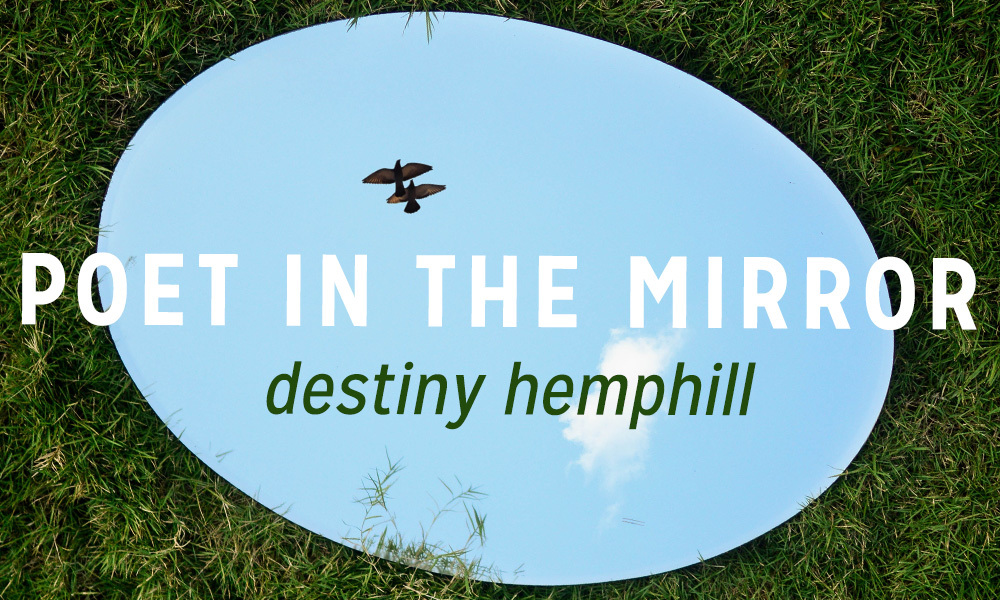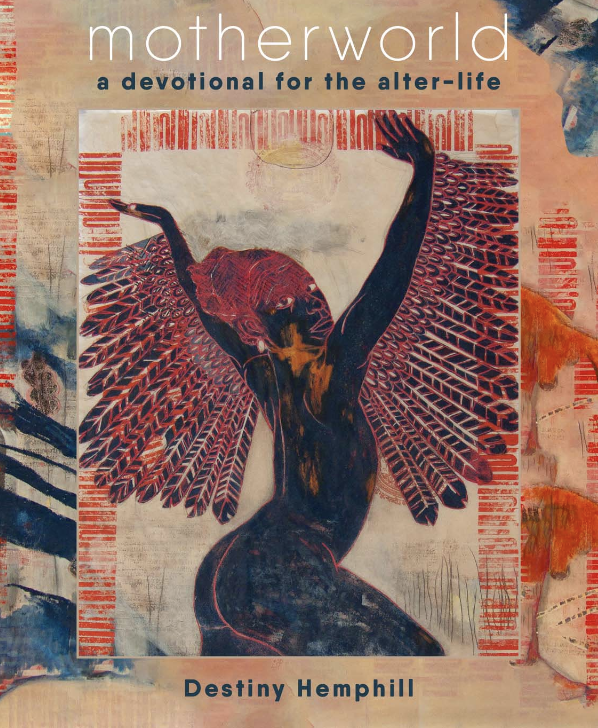Poet in the Mirror: Destiny Hemphill

We’re so proud to share some insight into the lives and hearts of today’s poets with our Poet In The Mirror series. This month, Destiny Hemphill—author of motherworld: a devotional for the alter-life (available now from Action Books) and a past Frontier contributor—shares insight into collaborative joys, book structure, and poetic lineages.
On Surprise
Huge congrats on motherworld: a devotional for the alter-life! I heard you read from this book at Kenyon this past summer, and it feels like such a gift to be holding the whole thing in my hands now. What was the most surprising thing—either a joyful one or a challenging one—about ushering this collection into the world?
Oh! Thank you! I’m so glad that we shared physical space together.
I’ve been delightfully surprised to receive invitations from other artists to collaborate around motherworld. A couple of years before motherworld got picked up for publication, I collaborated with Toshi Reagon on a song based on “apocalypso song #8 | the water chants,” which is a poem that appears in the manuscript. In 2021, Elise Logan, a brilliant dancer and choreographer, created a dance film based off of the “the portal” sequence for her undergraduate thesis at Barnard. And most recently, Monét Marshall recognized the manuscript as a performance text. She assembled an absolutely stunning all-Black, mostly queer and trans ensemble of folks to adapt and enflesh the manuscript as a performance ritual at NorthStar Church of the Arts in Durham, NC. I am forever grateful to Monét as well as Serayah Silver, Brittany Bennett Weston, King, and Raafe Purnsley for their yeses. I’m also in deep thanksgiving to our sound designer adé|dynamism x afrosurrealist research bureau, set designer Patience, lights designer Erin Bell, and stage manager Jenyane Robinson. It’s been humbling that so many people have wanted to expand the haptic, aural, and auric dimensions of the book because I do really want it to be a living text.
On Book Structure
Could you tell us a little bit about the assembly of this book? I’m particularly curious about the portals and some of the other recurring poem-types and how they organize the book.
motherworld is a triptych, where each of the three portals introduces a pivot. In this way, the portals are their own poems but also act as section breaks.
In the first section, “the portal appears,” we meet the manuscript’s collective of seekers and prophet-mothers as they reckon with the wreckage of a world wrought by colonial modernity.
In the second section, “the portal opens,” we encounter the collective as they sift and transmute the ruins of their receding world and invoke another world through ritual, spell, dreamwork, and prayer.
Finally, in the last section “the portal expands,” we get a sense of the emergent world as already existing in the receding one through practices of communal care (rather than state and institutionalized strategies of containment that get called “care”). In this final section, we meet a constellation of kindred who inhabit and tend to “now/here,” and we receive some of their names. This final section might feel the most near-present to readers.
In the manuscript, I wanted to depart from capitalist logics where linear notions of time and progress collapse into each other. Instead, “before” and “after” do not appear neatly distinct in the manuscript but are folded within each other. So the organization of the manuscript at the macro-level as well as the use of refrains and repeating poem-types became strategies to help create that slippage. Beyond that, the use of refrains and poem-types helps me layer rhythms—which, when I think about polyrhythms in Black diasporic sound, is a way to build, heighten, and/or shift energetic presence.
On Craft
What is a popular craft advice that you don’t practice yourself? (Or, what craft advice do you absolutely stand by?)
I am not a writer who writes every day. I had a season where I did for like maybe three months, and I think that season taught me a lot. But I actually go through long durations of time where I am not writing because of the way my chronic illness shows up while trying to survive the volatility and violence of capitalism. I think, in recent years, I have (gratefully) encountered more writers who are honest about not writing every day, and I want to be counted in that number!
On Lineages
To which lineages of poetics and thought does motherworld belong?
motherworld is the child of and is made possible by many. The child of Black Southern sermonic traditions—particularly the charismatic variety—which taught me much about call-and-response, anaphora, epistrophe, chiasmus, litany as well as how to leave space for spirit to move. The child of Black liberation practices that activated Black mysticism and divination. motherworld is indebted to the poetry and politics of the Black Arts Movement. To the literature and theory of Toni Cade Bambara and Octavia E. Butler. motherworld finds kinship with the poetics of Saretta Morgan, Asiya Wadud, Jada Renée Allen, Marlanda Dekine, and Tyree Daye to name just a few. & motherworld emerged from a soundscape woven from the sounds of ọrB, Sun Ra, Labelle, Celia Cruz, Elza Soares, Liniker, dynamism x afrosurrealist research bureau, and more.
 Destiny Hemphill is a chronically ill ritual worker and poet, living on the unceded territory of the Eno-Occaneechi band of the Saponi Nation (Durham, NC). A recipient of fellowships from Naropa University’s Summer Writing Program, Callaloo, Tin House, and Kenyon Review’s Writers Workshop, she is the author of the poetry chapbook Oracle: a Cosmology (Honeysuckle Press, 2018) and the collection motherworld: a devotional for the alter-life (Action Books 2023). She is currently serving as the 2022-2023 Kenan Visiting Writer in Poetry at the University of North Carolina-Chapel Hill.
Destiny Hemphill is a chronically ill ritual worker and poet, living on the unceded territory of the Eno-Occaneechi band of the Saponi Nation (Durham, NC). A recipient of fellowships from Naropa University’s Summer Writing Program, Callaloo, Tin House, and Kenyon Review’s Writers Workshop, she is the author of the poetry chapbook Oracle: a Cosmology (Honeysuckle Press, 2018) and the collection motherworld: a devotional for the alter-life (Action Books 2023). She is currently serving as the 2022-2023 Kenan Visiting Writer in Poetry at the University of North Carolina-Chapel Hill.